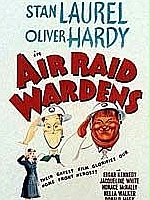
Laurel and Hardy were a British-American comedy duo act during the early Classical Hollywood era of American cinema, consisting of Englishman Stan Laurel (1890–1965) and American Oliver Hardy (1892–1957). Starting their career as a duo in the silent film era, they later successfully transitioned to "talkies". From the late 1920s to the mid-1950s, they were internationally famous for their slapstick comedy, with Laurel playing the clumsy, childlike friend to Hardy's pompous bully. Their signature theme song, known as "The Cuckoo Song", "Ku-Ku", or "The Dance of the Cuckoos" was heard over their films' opening credits, and became as emblematic of them as their bowler hats.

The Music Box is a Laurel and Hardy short film comedy released in 1932. It was directed by James Parrott, produced by Hal Roach and distributed by Metro-Goldwyn-Mayer. The film, which depicts the pair attempting to move a piano up a long flight of steps, won the first Academy Award for Best Live Action Short (Comedy) in 1932. In 1997, it was selected for preservation in the National Film Registry by the Library of Congress as being "culturally, historically, or aesthetically significant". The short is widely seen as the most iconic Laurel and Hardy short, with the featured stairs becoming a popular tourist attraction.

Oliver Norvell Hardy was an American comic actor and one half of Laurel and Hardy, the double act that began in the era of silent films and lasted from 1926 to 1957. He appeared with his comedy partner Stan Laurel in 107 short films, feature films, and cameo roles. He was credited with his first film, Outwitting Dad, in 1914. In most of his silent films before joining producer Hal Roach, he was billed on screen as Babe Hardy.

Babes in Toyland is a Laurel and Hardy musical Christmas film released on November 30, 1934. The film is also known by the alternative titles Laurel and Hardy in Toyland, Revenge Is Sweet, and March of the Wooden Soldiers, a 73-minute abridged version.

Stan Laurel was an English comic actor, writer, and film director who was one half of the comedy duo Laurel and Hardy. He appeared with his comedy partner Oliver Hardy in 107 short films, feature films, and cameo roles.

Laurel and Hardy were a motion picture comedy team whose official filmography consists of 106 films released between 1921 and 1951. Together they appeared in 34 silent shorts, 45 sound shorts, and 27 full-length sound feature films. In addition to these, Laurel and Hardy appeared in at least 20 foreign-language versions of their films and a promotional film, Galaxy of Stars (1936), produced for European film distributors.

Way Out West is a 1937 Laurel and Hardy comedy film directed by James W. Horne, produced by Stan Laurel, and distributed by Metro-Goldwyn-Mayer. It was the second picture for which Stan Laurel was credited as producer.

James Henderson Finlayson was a Scottish actor who worked in both silent and sound comedies. Balding, with a fake moustache, he had many trademark comic mannerisms—including his squinting, outraged double-take reactions, and his characteristic exclamation: "D'ooooooh!" He is the best remembered comic foil of Laurel and Hardy.

Pardon Us is a 1931 American pre-Code Laurel and Hardy film. It was the duo's first starring feature-length comedy film, produced by Hal Roach and Stan Laurel, directed by James Parrott, and originally distributed by Metro-Goldwyn-Mayer in 1931.
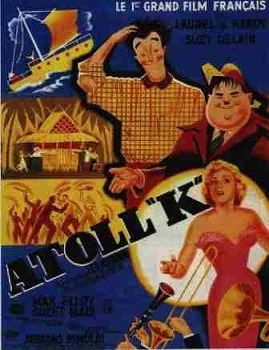
Atoll K is a 1951 Franco-Italian co-production film—also known as Robinson Crusoeland in the United Kingdom and Utopia in the United States – which starred the comedy duo Laurel and Hardy in their final screen appearance. The film co-stars French singer/actress Suzy Delair and was directed by Léo Joannon, with uncredited co-direction by blacklisted U.S. director John Berry.
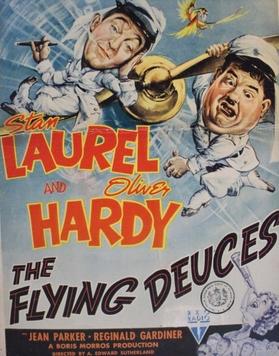
The Flying Deuces, also known as Flying Aces, is a 1939 buddy comedy film starring Laurel and Hardy, in which the duo join the French Foreign Legion. It is a partial remake of their short film Beau Hunks (1931).

Our Wife is a 1931 American pre-Code Hal Roach comedy film starring Laurel and Hardy. It was directed by James W. Horne and released by Metro-Goldwyn-Mayer.
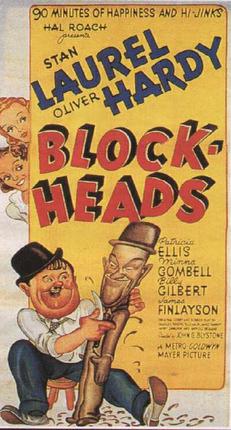
Block-Heads is a 1938 American comedy film directed by John G. Blystone and starring Stan Laurel and Oliver Hardy. It was produced by Hal Roach Studios for Metro-Goldwyn-Mayer. The film, a reworking of elements from the Laurel and Hardy shorts We Faw Down (1928) and Unaccustomed As We Are (1929), was Roach's final film for MGM.
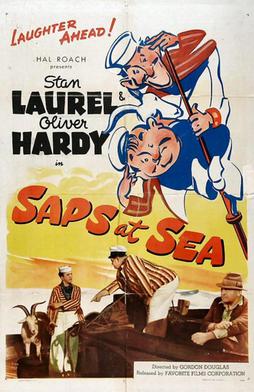
Saps at Sea is a 1940 American comedy film directed by Gordon Douglas, distributed by United Artists. It was Laurel and Hardy's last film produced by the Hal Roach Studios, as well as the last film to feature Ben Turpin and Harry Bernard.
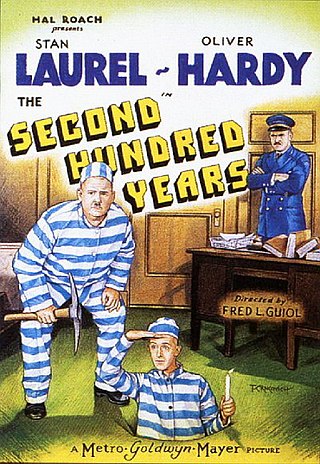
The Second Hundred Years is a 1927 American silent comedy short film starring Stan Laurel and Oliver Hardy prior to their official billing as the duo Laurel and Hardy. The team appeared in a total of 107 films between 1921 and 1951.

Tit for Tat is a 1935 short comedy film starring Stan Laurel and Oliver Hardy. It is the only direct sequel they made, following the story of Them Thar Hills, which was released the previous year and includes the same two supporting characters, Mr. and Mrs. Hall, portrayed by Charlie Hall and Mae Busch. This "two-reeler" is notable too for being nominated for an Academy Award as Best Live Action Short Film (Comedy) of 1935, although it did not win. It also has a central theme similar to the comedy duo's 1929 silent short Big Business. In the opening scene of Tit for Tat, Oliver places a sign in the front window of his and Stan's electrical store. It reads "Open for Big Business", an allusion to the escalating revenge and "reciprocal destruction" common to both films.

Swiss Miss is a 1938 comedy film starring Laurel and Hardy. It was directed by John G. Blystone, and produced by Hal Roach. The film features Walter Woolf King, Della Lind and Eric Blore.

The Live Ghost is a 1934 American comedy short film starring Laurel and Hardy, directed by Charles Rogers, and produced by Hal Roach at his studios in Culver City, California.

Outwitting Dad is a lost 1914 American silent comedy film produced by the Lubin Manufacturing Company and featuring Billy Bowers, Raymond McKee, and Oliver Hardy in his first known screen appearance.

Stan & Ollie is a 2018 biographical comedy-drama film directed by Jon S. Baird. The script, written by Jeff Pope, was inspired by Laurel and Hardy: The British Tours by A.J. Marriot which chronicled the later years of the comedy double act Laurel and Hardy; the film stars Steve Coogan and John C. Reilly as Stan Laurel and Oliver Hardy. The film focuses on details of the comedy duo's personal relationship while relating how they embarked on a gruelling music hall tour of the United Kingdom and Ireland during 1953 and struggled to get another film made.
